We tested the best meal replacement bars on the market today according to price, calories per ounce, macros, ingredients, and taste. Read on to see how they performed, which is best for you, and get some valuable buying advice.
Table of Contents
Best Meal Replacement Bars
The best meal replacement bars are:
- Best Overall Meal Replacement Bar for Calories, Macros & Nutrition, and Taste: GREENBELLY Meals Meal2Go
- Meal Replacement Bar With the Cleanest Ingredients: SANS Meal Bar
- Best Macro Balance: GOMACRO MacroBar
- Meal Replacement Bar With The Most Protein: MET-RX Big 100 Colossal
- Best for Snacking: BOBO'S Stuff'd Oat Bar
- Most Calorically Dense Meal Replacement Bar: PROBAR Meal
- Tastiest Meal Replacement Bar: KATE'S REAL FOOD
The product comparison table below is sortable. Click the arrow in the heading cell to sort the models by preferred spec.
| MODEL | PRICE PER PACKAGE |
WEIGHT PER PACKAGE |
CALORIES PER PACKAGE |
PROTEIN PER PACKAGE |
FIBER PER PACKAGE |
FAT PER PACKAGE |
SUGAR PER PACKAGE |
SCORE |
|---|---|---|---|---|---|---|---|---|
| 1. Greenbelly Meals Meal2Go | $6.83 | 5.5 oz | 665 | 18 g | 10 g | 23 g | 28 g | 8/10 |
| 2. Sans Meal Bar | $3.29 | 3 oz | 390 | 15 g | 7 g | 23 g | 23 g | 8/10 |
| 3. GoMacro Macrobar | $3.21 | 2.3 oz | 290 | 11 g | 2 g | 11 g | 14 g | 7/10 |
| 4. MET-RX Big 100 Colossal | $4.99 | 3.5 oz | 410 | 30 g | 1 g | 12 g | 18 g | 7/10 |
| 5. Bobo's Stuff'd Oat Bar | $2.49 | 2.5 oz | 330 | 6 g | 4 g | 17 g | 16 g | 7/10 |
| 6. ProBar Meal | $3.33 | 3 oz | 400 | 11 g | 6 g | 22 g | 19 g | 7/10 |
| 7. Kate's Real Food | $2.49 | 2.2 oz | 130 | 3 g | 2 g | 6 g | 9 g | 7/10 |
Best Overall Meal Replacement Bar
Greenbelly Meals Meal2Go
Price per package: $6.83
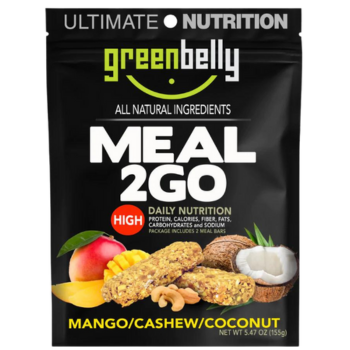
✅ Great macro balance
✅ Flavorful
✅ Full meal in each package
❌ Large size is more costly per package
KEY SPECS
- Weight per package: 5.5 oz
- Varieties of flavors: 5
- Calories per package: 665
- Protein per package: 18 g
- Fiber per package: 10 g
- Fat per package: 23 g
- Sugar per package: 28 g
- Artificial sweeteners?: No
- Minimally processed?: Yes
The Greenbelly Meals Meal2Go is our pick for the best overall meal replacement bar. Ok, sure, we’re a bit biased, but hear us out. Each package contains 650-695 calories, depending on which of the 5 flavors you choose. This makes the total calories close to a full meal. All the other bars on our list are under 400 calories per package.
We designed these bars to have a well-balanced nutritional profile providing about a third of your daily value for 6 nutrients (calories, fats, fiber, carbs, protein, and sodium). The bars are thick and dense yet fluffy, like a rice crispy treat with nourishing ingredients like gluten-free oats, dried fruits, and nuts. And they taste yummy - a little salty and a little sweet.
The only drawback is that the price per package is the highest of any we tested. But considering they're almost double the calories and macros of other bars, we think they are good value.
Meal Replacement Bar With the Most Macros & Cleanest Ingredients
Sans Meal Bar
Price per package: $3.29
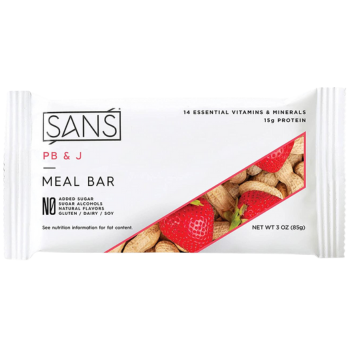
✅ Calorically dense
✅ Cleanest ingredients
✅ Lots of macros
❌ Poor macro balance
KEY SPECS
- Weight per package: 3 oz
- Varieties of flavors: 4
- Calories per package: 390
- Protein per package: 15 g
- Fiber per package: 7 g
- Fat per package: 23 g
- Sugar per package: 23 g
- Artificial sweeteners?: No
- Minimally processed?: Yes
Sans meal bars are a close second to Greenbelly for best meal bars. We love that these are high-calorie bars, some of the most calorically dense on our list. And they have the cleanest ingredient list of the bars we tested.
Sans meal bars don’t have soy, gluten, dairy, artificial flavors, or added sugar. They are packed with tons of natural flavor and naturally occurring sugar from fruit and are a great source of protein and fiber. Depending on the flavor, each bar has between 14 and 17 different vitamins and minerals.
Their overall balance of macros is low on carbs since they don't have added sugar. With each bar weighing 3 ounces and containing 390 calories, you may want to double up if you’re replacing a complete meal with these bars.
Best Macro Balance
GoMacro Macrobar
Price per package: $3.21

✅ Great macro balance
✅ Clean ingredients
❌ Less overall macros
❌ Flavors all taste similar
KEY SPECS
- Weight per package: 2.3 oz
- Varieties of flavors: 14
- Calories per package: 290
- Protein per package: 11 g
- Fiber per package: 2 g
- Fat per package: 11 g
- Sugar per package: 14 g
- Artificial sweeteners?: No
- Minimally processed?: Yes
GoMacro Macrobar checks all the ingredients and dietary boxes—organic, clean protein source (brown rice and pea), Gluten-Free, Non-GMO, and Vegan.
Each bar is certified R.A.W. They have a mealy texture and are filled with ingredients like peanuts, peanut butter, dates, and fair-trade chocolate chips. These have the best macro balance, tied with Greenbelly for the best overall. But they have fewer macros overall.
We like that they aren’t too sweet, but there isn’t as much flavor distinction between the 14 different flavors as we'd like. As a cool bonus, the GoMacro factory uses 100% renewable energy to make the bars, along with labels that are manufactured out of 100% post-consumer waste. Similar to other bars on this list, they are better for snacking.
Best Meal Replacement Bar For Protein
MET-Rx Big 100 Colossal
Price per package: $4.99
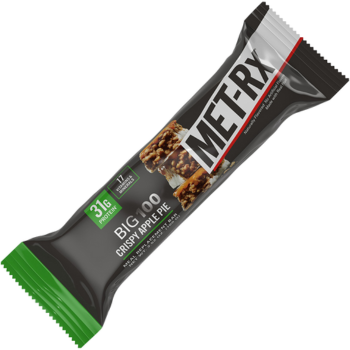
✅ Macro packed
✅ Good macro balance
❌ Costs more per calorie
❌ Uses processed ingredients
KEY SPECS
- Weight per package: 3.5 oz
- Varieties of flavors: 8
- Calories per package: 410
- Protein per package: 30 g
- Fiber per package: 1 g
- Fat per package: 12 g
- Sugar per package: 18 g
- Artificial sweeteners?: No
- Minimally processed?: No
With an impressive 32 grams of protein, the Met-RX Big 100 Colossal is marketed as weight lifting meals bars for bulking up. We love that they pack a ton of macros and have a good macro balance.
You may need a scientist to pronounce some of the ingredients though. Of all the meal bars we tested, these use the most processed ingredients. Some of these ingredients can cause stomach issues if you eat too many of them.
The cost per calorie is the second highest on our list. The taste is good, like a chocolate-covered crunch bar, but it does get old if you eat multiple Met-RX bars in a day.
Best Dense Nutrition Bar for Snacking
Bobo's Stuff'd Oat Bar
Price per package: $2.49

✅ Great price per calorie
✅ High calories per ounce
✅ Good ingredient list
❌ Lower amounts of macros
❌ Less tasty
❌ Small size
KEY SPECS
- Weight per package: 2.5 oz
- Varieties of flavors: 4
- Calories per package: 330
- Protein per package: 6 g
- Fiber per package: 4 g
- Fat per package: 17 g
- Sugar per package: 16 g
- Artificial sweeteners?: No
- Minimally processed?: Yes
Bobo’s Stuff’d Oat Bars are a treat for anybody who loves nut butter, as there’s a hearty helping stuffed in its center. The outside of the bar is a baked outer shell made of ingredients like organic oats, coconut oil, coconut, and peanuts.
We found the taste of this bar wasn’t very sweet, and it had a dry, crunchy, crumbly texture. We wish the total macros and macro balance were higher.
We like that for the price and weight Bobo's packs a lot of calories. But at just 2.5 ounces, we think the Bobo’s is best as a snack-sized bar. We would recommend doubling up if you’re replacing a full meal.
Most Calorically Dense Meal Replacement Bar
ProBar Meal
Price per package: $3.33

✅ High calories per ounce
✅ High macros per ounce
✅ Good budget option
❌ Not as tasty
❌ Low macro balance
KEY SPECS
- Weight per package: 3 oz
- Varieties of flavors: 12
- Calories per package: 400
- Protein per package: 11 g
- Fiber per package: 6 g
- Fat per package: 22 g
- Sugar per package: 19 g
- Artificial sweeteners?: No
- Minimally processed?: Yes
Probar Meal bars are high-calorie bars that pack a whopping 133 calories per ounce, making them the most calorically dense bars on our list. We like that they pack in a lot of macros and are a good value with lots of calories per dollar.
The biggest downside for us is the macro balance. We would have liked to see more carbs and a little less fat for a true meal replacement bar.
The ingredients list is mostly good, with whole chunks of fruits, nuts, chia, and flaxseed. However, these bars have a lot of added sugar, which makes the flavor a little too sweet for our liking. The texture of these bars is a mix of chewy and crunchy.
Tastiest Meal Replacement Bar
Kate's Real Food
Price per package: $2.49
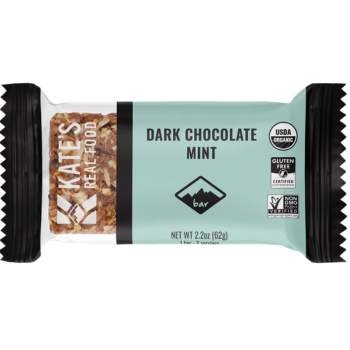
✅ Tastiest Bar
✅ Wholesome ingredients
❌ Expensive per calorie
❌ Low calories per ounce
❌ Low macros per serving
KEY SPECS
- Weight per package: 2.2 oz
- Varieties of flavors: 7
- Calories per package: 130
- Protein per package: 3 g
- Fiber per package: 2 g
- Fat per package: 6 g
- Sugar per package: 9 g
- Artificial sweeteners?: No
- Minimally processed?: Yes
Kate’s Real Food bars were some of the tastiest bars we tested. They skew slightly sweeter than saltier. We love the clean ingredient list, one of the best on our list. The bar comes with a hearty helping of organic oats, dark chocolate, peanut butter, fiber-packed raisins, and brown rice crisps which give it a dense, moist, chewy texture.
We didn’t like that the total macros per ounce were the lowest on our list and that the overall macro balance wasn’t as good as other bars. At 2.2 ounces, this is the smallest bar we tested, packing only 130 calories in total.
Because of this size, it’s best for a snack or packed multiple bars if you’re trying to replace a full meal. All of their 7 flavors are gluten-free.
Key Factors To Consider When Choosing
Price
Inexpensive meal replacement bars are often smaller or made with more processed ingredients. Premium meal replacement bars have quality, whole ingredients, are full of macros, and are packed with calories.
When assessing price, look at how many calories you are getting for your money. In some cases, you might need 2 smaller, less expensive bars to make a full meal.
Meal replacement bars that provide the greatest value:
Most affordable meal replacement bars (most calories per $1):
Premium meal replacement bars (least calories per $1):
Calories Per Ounce
Meal replacement bars should be noticeably heavier and more substantial in size due to the additional, nutrient-dense foods they're packed with. Hiking isn't the time to skimp on calories or pick food that falls under the “weight loss” category.
To get enough calories, you’ll want a bar that’s at least 3 ounces or more in weight and packs in at least 300 calories, ideally closer to 500-600.
The most calorically dense meal replacement bars:
Macros
Macronutrients are carbohydrates, fats, and protein, which are the nutrients you use in the largest amounts. We’ll cover them in more detail below, but in general, carbohydrates provide instant energy, fats provide long-term energy, and proteins build muscle framework and structure.
Getting enough of these is essential but the balance of these macros is just as important. The USDA recommends the total calories of a meal to be 45-65% carbs, 20-35% fats, and 10-35% protein.
Meal replacement bars with the best balance of macros:
The best meal replacement bars for protein:
The best meal replacement bars for fiber:
The best meal replacement bars for fats:
Ingredients
The quality of the ingredients that make up a meal replacement bar is just as important as the macros. Look for minimally processed, whole foods with no artificial sweeteners. These foods are easier for your body to digest on top of being healthier. We will cover more specific details later in this article.
The best meal replacement bars for minimally processed ingredients:
Other Things to Consider
Ingredients
As we mentioned above, it’s important to get enough macronutrients as well as the correct balance of them. Make sure that your meal replacement bars contain only quality, whole foods that are minimally processed and free of artificial sweeteners. Below are specific recommendations.

Protein
Protein is an essential macronutrient to any well-rounded meal, and we recommend at least 10g per serving. It keeps you full and helps build strong bones and muscles.
Like with protein bars, different kinds of protein are used in different kinds of meal replacement bars.
Here’s a look at the most common sources:
- Whey – Stemming from milk, whey is a complete protein with all 9 essential amino acids. It can aid in muscle recovery and growth, especially during endurance activities.
- Soy – A staple in plant-based diets, soy comes in many forms, from powder to tofu, edamame to tempeh. A ½ cup can give anywhere from 7-10 grams of protein, along with high levels of iron and calcium (important if following a non-dairy diet!)
- Pea – Pea protein has gained some popularity over the years, probably because you can get over 25% of your daily fiber and around 9 grams of protein in a single cup.
- Brown Rice – This protein is a great option for people with food allergies because brown rice is naturally hypoallergenic. It’s also loaded with antioxidants.
- Quinoa – Like oats, quinoa is a grain often ground into flour and used to make baked goods. It’s a complete source of protein, with around 9 grams per cup.
- Oats – Just ½ a cup can give you over 6g/protein. It’s not a complete protein, but oats keep you full and are high quality and clean.
- Seeds, nuts, and nut butter – An excellent source of healthy fat and fiber, foods like peanuts, almonds, chia seeds, and nut butter can have more than 2g/protein in a single tablespoon.
Many dieticians suggest at least 10g of protein per bar to stay nourished and more if you are trying to build muscle. Protein also helps you feel full and satiated, so you won’t be hungry immediately afterward.

Sugar
Sugar is simple; the cleaner and more natural the sugar is, the easier it is on your body. We recommend bars that have 100% natural sugars. Artificial sweeteners are much harder for your body to digest and can result in the dreaded “gut rot” feeling.
The best source of sugar comes from whole ingredients like fruit. If you check the back of most bars, they will break down total sugar from added sugar. The difference is the sugar from the fruit and other ingredients in the bar.
Some of the better natural sugars are cane sugar, honey, agave syrup, maple syrup, and tapioca syrup. And it’s even better if it’s organic. All these sugars come from recognizable plants, aren’t genetically modified, and are easier to digest.

Sweeteners
Some artificial sweeteners are sugar alcohols that end in “-ol” like xylitol, erythritol, and sorbitol. They are known to cause digestive problems because they aren’t fully digestible.
Other sweeteners like maltodextrin and corn syrup also should be avoided. They are at the very top of the glycemic index, meaning your blood sugar skyrockets when ingesting it and increases your likelihood of crashing afterward.

Greenbelly Meal2Go ingredients on pack.
Fiber
Fiber keeps our digestion consistent and slows down our body’s absorption of sugar, so we keep more regulated blood sugar. The USDA suggests 25-35g of fiber per day, so look for bars with at least 8g of fiber.

Kate's Real Food ingredients on pack.
Whole Foods
Quite simply, whole foods mean nutrient-rich ingredients with little to no processing. Reading the ingredient list and seeing if you can pronounce everything is a great place to start. Have you seen these ingredients at the grocery store, or do they come from a lab?
Whole food contains tons of micronutrients, vitamins, and minerals our body needs to operate efficiently and effectively. They are easier to digest and won’t leave us hungry 15 minutes later.
We recommend keeping food as natural and minimally processed as possible. They should also be free of food additives like maltodextrin, for example, which is a common ingredient found in packaged foods.

A Bobo's Peanut Butter Chocolate Chip Oat Bar.
Dietary Restrictions
Vegan, gluten-free, and keto bars are all available. Nowadays, it’s easy to find vegan bars. Just make sure to check for any honey or egg whites. Gluten-free bars are also easy to find and will clearly be labeled GF. Also, make sure to check that the oats are certified gluten-free.
Keto bars are a bit more challenging to find as the primary source of calories is typically carbs. Depending on how strict your carb intake is, this might be a time to choose artificial sweeteners over natural sweeteners.

Gomacro Macrobar ingredients on pack.
Packaging
It’s no secret you should always take out of the forest whatever you bring in (Leave No Trace Principles and all that). But if you want to take your green efforts one environmentally-friendly step further, then investing in meal replacement bars with recyclable packaging is a good place to start.
Not all plastic packaging is created the same. You can tell if your bar’s plastic is recyclable by checking the back label for a symbol like 3 arrows forming a triangle (♻️) or a note about being compostable.

Different packaging of meal replacement bars.
Taste & Texture
There are two ways to make meal bars. Some are cold-pressed, and others are made using a process called extrusion. The process used will affect how the bar tastes and its overall texture.
- Extruded bars are made by blending the ingredients and injecting them into a bar shape. Cooking of the bars is done by using large external heaters. This is a common process used in the creation of several packaged foods, and its method results in a very consistent, mealy texture.
- Pressed bars are made by mixing the ingredients and pressing them into a bar shape. They are either baked or refrigerated. The theory behind pressed bars is that the ingredients withhold their highest level of nutritional value because they remain in their most natural state. We find these bars have a more flavorful taste and chunky and crunchy texture, which makes them closer to eating a real meal.

A squirt of Justin's nut butter on a dark chocolate/banana Meal2Go is the perfect combo.
FAQs
Why Meal Replacement Bars?
1. Fast. A meal replacement bar is a well-balanced, immediate meal you can eat while you’re still movin’ and groovin’ on the trail. They’re carefully crafted to fill in as a healthy, full-meal alternative, and there’s no stopping or cooking required. The bars are ready-to-eat whenever hunger strikes.
2. Easy. With a meal replacement bar, there’s no clean-up! There’ll be enough of that on the trail already, so it’s nice to have an alternate, satisfying food option that doesn’t take much work. Or planning. Just be sure to pack out your wrappers so they can be properly (and responsibly!) recycled or disposed of.
3. Compact. One of the great things about meal replacement bars is you can pack a whole bunch of them, and they hardly weigh a thing or take up much room in your pack. They’re often no bigger than the size of your hand, and they come in airtight packaging that’s durable and keeps them well protected.
4. Filling. Where granola bars, protein bars, and even ramen noodles make for great lightweight snacks or meal starters, they don’t contain enough calories or nutritional value alone to be a complete meal like a meal replacement bar is.

Greenbelly Meal2Go and ingredients on pack.
How to Make Your Own Meal Replacement Bars
With the right ingredients, you can whip up a batch of customized meal replacement bars right at home. They’re relatively easy to make and often only require blending, mixing, melting, spreading, and baking or refrigerating, depending on the recipe.
Ingredients: Many meal replacement bars include common household ingredients like oats, nuts, seeds, nut butter, maple syrup or honey, coconut or olive oil, eggs, and spices. You can customize recipes however you want by swapping out ingredients or adding other items like coconut flakes, chocolate chips, or dried fruit.
Gear: To get started on making a batch, all you need is a mixing bowl, a small pot, parchment or wax paper, a blender, a pan or baking dish, a spatula, an oven (or a fridge if it’s a no-bake bar), and, of course, the right recipe! Here’s two to get you started.
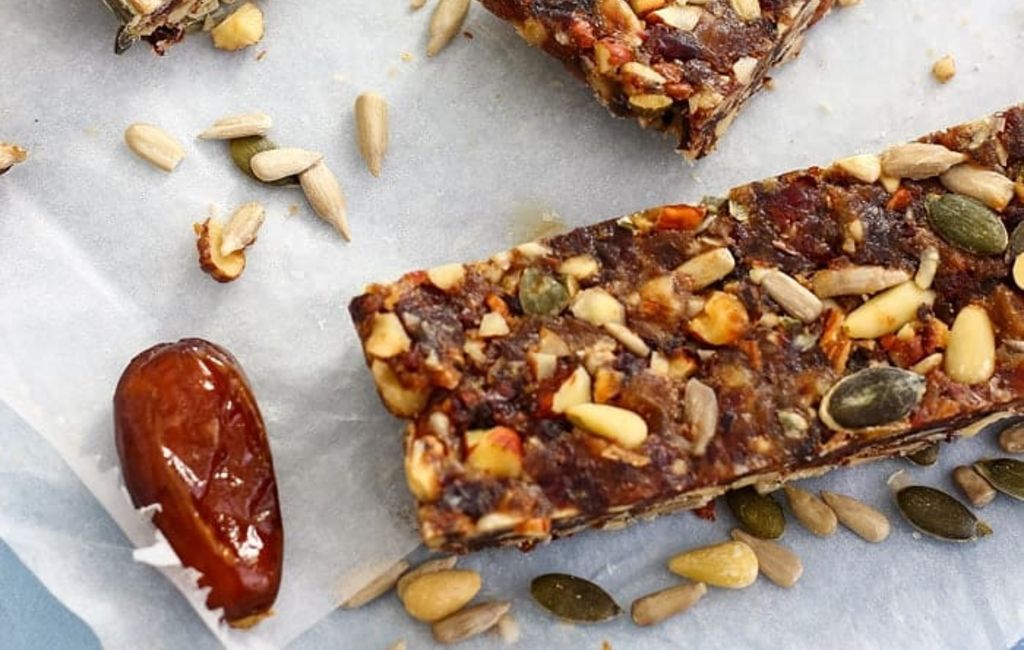
Are protein bars good meal replacements?
No, protein bars are not good meal replacements. Protein bars tend to focus specifically on one ingredient, protein. These bars typically will not have a full spectrum of nutrients and won’t fuel your body with carbs and fats to keep you going throughout the day.
While they may make you feel full, your body will still need many other nutrients to operate efficiently. Protein bars are a great supplemental product if you are looking to build muscle but aren’t great for truly replacing a meal.







 650-Calorie Fuel
650-Calorie Fuel



